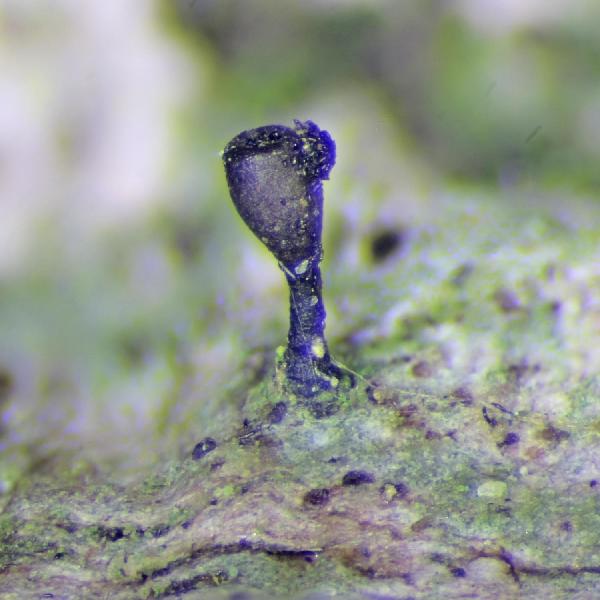Stenocybe septata (Leight.) A. Massal.
Atti Ist. Veneto Sci. Lett. Arti, Ser. 3, 5: 267, 1860. Basionym: Sphinctrina septata Leight. - Ann. Mag. nat. Hist., Ser. 2, 19: 132, 1857
Synonyms:
Distribution: N - TAA.
Description: Thallus not evident, not lichenized. Apothecia stalked, pin-like, up to 1.8 mm high, shiny black, single or sometimes 2-3 united at base, the stalk slender, to 0.15 mm thick, sometimes branched and bearing 2-3 capitula, consisting of dark brown, periclinally arranged hyphae, surrounded by a gelatinous coat. Capitulum narrowly clavate, shining black, with a prominent exciple; mazaedium absent. Epithecium dark brown, thin, of interwoven sclerotized hyphae; exciple well-developed, consisting of 4-7 layers of dark brown, periclinally arranged hyphae; paraphyses absent. Asci 8-spored, cylindrical, formed singly from ascogenous hyphae with croziers, uniformly thickened at apex, with a single functional wall layer, persisting until the spores are ejected, with uniseriately arranged spores. Ascospores (1-)3(-6)-septate, red-brown, ellipsoid or elongate-ellipsoid, thickened at septa, (35-)45-60(-90) x (11-)15-20 µm, one or both apical cells often with a paler, extended point. Photobiont absent. Spot tests: K-, C-, KC-, P-. Chemistry: without lichen substances.
Note: on bark of broad-leaved trees (mainly Ilex); a rare species of old woodlands, mainly in Western Europe, with a few ancient records from the Eastern Alps (Austria and Italy), which however need confirmation.
Growth form: Fungus
Substrata: bark
Reproductive strategy: mainly sexual
Most common in areas with a humid-warm climate (e.g. most of Tyrrenian Italy)
Commonnes-rarity: (info)
Alpine belt: absent
Subalpine belt: absent
Oromediterranean belt: absent
Montane belt: extremely rare
Submediterranean belt: absent
Padanian area: absent
Humid submediterranean belt: absent
Humid mediterranean belt: absent
Dry mediterranean belt: absent

Predictive model
Growth form: Fungus
Substrata: bark
Reproductive strategy: mainly sexual
Most common in areas with a humid-warm climate (e.g. most of Tyrrenian Italy)
Commonnes-rarity: (info)
Alpine belt: absent
Subalpine belt: absent
Oromediterranean belt: absent
Montane belt: extremely rare
Submediterranean belt: absent
Padanian area: absent
Humid submediterranean belt: absent
Humid mediterranean belt: absent
Dry mediterranean belt: absent

Predictive model
 INDEX FUNGORUM
INDEX FUNGORUM
 GBIF
GBIF
 DOLICHENS
DOLICHENS


